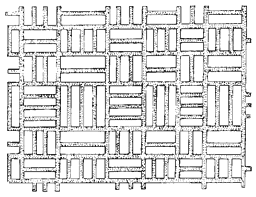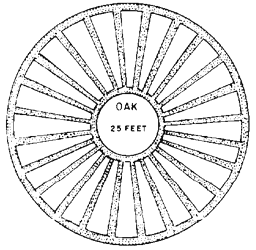 |
Science Frontiers ONLINE No. 68: Mar-Apr 1990 |
|
|
Michigan's prehistoric garden beds
 Type 5. Parallel beds. Width of beds, 6 feet; paths, 4 feet; length, 12-40 feet; height, 18 inches. |
First, Hubbard's general description of the "garden beds":
"The so-called 'Garden Beds' were found in the valleys of the St. Joseph and Grand Rivers, where they occupied the most fertile of the prairie land and burr-oak plains, principally in the counties of St. Joseph, Cass and Kalamazoo.
"They consisted of raised patches of ground, separated by sunken paths, and were generally arranged in plats or blocks of parallel beds. These varied in dimensions, being from five to sixteen feet in width, in length from twelve to more than one hundred feet, and in height from six to eighteen inches.
"The tough sod of the prairie had preserved very sharply all the outlines. According to universal testimony, these beds were laid out and fashioned with skill, order and symetry which distinguished them from the ordinary operations of agriculture, and were combined with some peculiar features that belong to no recognized system of horticultural art."
 Type 8. Wheel-shaped plats. Width of beds, 6-20 feet; paths, 1 foot; length, 14-20 feet. |
Hubbard gave no figure for the total extent of the beds. Individual plats ran from 20 to 300 acres. Considering that they stretched for miles through three counties, we are certainly talking about thousands of acres. Hubbard stated that the usual pottery, arrowheads, spear points, and related artifacts seemed to be absent from the areas of the beds.
(Hubbard, Bela; "Ancient Garden Beds of Michigan," American Antiquarian, 1:1, 1878. Reprinted in : INFO Journal, 12:6, no. 2, 1989. INFO = International Fortean Organization, P.O. Box 367, Arlington, VA, 22210.)
Reference. This article is also reprinted in our handbook: Ancient Man. To order this huge compilation, visit: here.